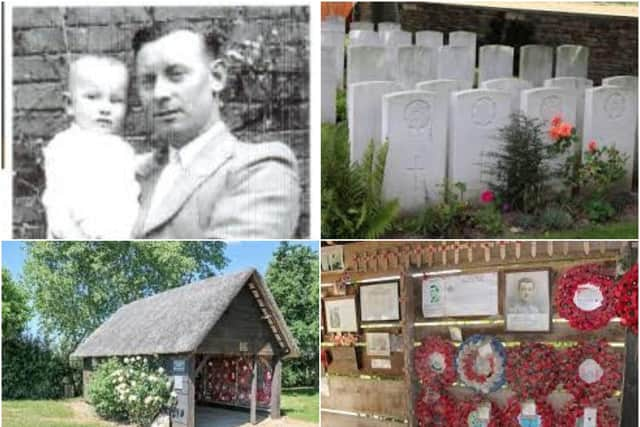Dunkirk 80th Anniversary: The Warwick Men in the Wormhoudt Massacre
and live on Freeview channel 276
Unlocking Warwick is researching the stories behind the names of those who died in the Second World War on the Church Street memorial in the town. They are asking people to get in touch with information about those who died, and also if they have memories of life in Warwick during the war.
Here are more of the stories behind the names on Warwick’s war memorial in Church Street uncovered by the volunteers of Unlocking Warwick.
Advertisement
Hide AdAdvertisement
Hide AdUnlocking Warwick’s researchers have established that three of the men commemorated on the war memorial in Church Street were murdered in the notorious Wormhoudt /Esqualecq Massacre of 1940.


This week is the 80th anniversary of the Dunkirk evacuation, when the British Expeditionary Force in France were forced into a chaotic retreat by the German Blitzkrieg.
The Royal Warwickshire Regiment was among those holding off the German advance, allowing hundreds of thousands of men to be rescued from the beach at Dunkirk.
Unlocking Warwick’s researchers have established that three of the men commemorated on the war memorial in Church Street were murdered during that rearguard action in the notorious Wormhoudt /Esqualecq Massacre of May 28, 1940.
Advertisement
Hide AdAdvertisement
Hide AdSecretary of the volunteer group, Rick Thompson said: “The son of Thomas White, also called Thomas and known as Tom, has responded to our appeal for pictures and information.
“The White family lived at 17 Market Street. Tom’s father had been reported missing as the British Expeditionary Force retreated towards Dunkirk, and only about a year later his mother received news of her husband’s death, being told he had been ‘killed in action’.
“She died in 1989 and never knew the truth about her husband’s death.
“Tom didn’t find out the full story until he himself was 72 years old.”
Advertisement
Hide AdAdvertisement
Hide AdHe says: “Over the years I became curious about what had happened to my father. I wrote to various government departments but could never discover the truth.
“Then one day I went to St John’s Museum, (the museum of the Royal Warwickshire Regiment now part of the Fusiliers), and a chap suggested I look at a book titled The Forgotten Massacre by Guy Rommelaere.
“To my surprise I found my dad’s name in the back”.
As the British Expeditionary Force was retreating towards Dunkirk, overrun by advancing German forces, British troops from the 48th (South Midland) Infantry Division of the 2nd Warwickshires were holding a key road at Wormhoudt against elite German divisions, delaying their advance and helping more than 330,000 men to escape to Britain.
When they ran out of ammunition they surrendered, expecting they would be taken prisoner according to the Geneva Convention. But their captors were the Waffen-SS division Leibstandarte SS Adolf Hitler.
Advertisement
Hide AdAdvertisement
Hide AdAlong with some French troops, nearly 100 men were herded into a barn.
Some were taken out and shot, grenades were thrown in, and the barn was sprayed with machine-gun fire.
Some of the soldiers survived because two NCOs, Sgt Stanley Moore and CSM Augustus Jennings, hurled themselves on top of the grenades using their bodies to suppress the explosions.
Eighty men were killed outright, nine more died of their wounds within two days, six survived and were taken to hospital by the regular soldiers of the German army.
Advertisement
Hide AdAdvertisement
Hide AdThomas White Junior has visited his father’s grave in France, and seen the small museum in a recreated barn or cowshed that commemorates those who were murdered there.
Those names include two more who are also honoured on the Warwick war memorial, Arthur Williams and Thomas George.
Arthur Williams’ family came from Lowsenford. Arthur, the oldest of five children, came to live in Warwick in 1925.
He enlisted in the Royal Warwickshire Regiment in 1931 and married Lottie Russell in 1933.
Advertisement
Hide AdAdvertisement
Hide AdHe left the army in 1938 to work at the Warwick Aviation Company, but with the outbreak of war he was called up as a reservist.
Thomas George’s family lived at 55 Lakin Road. He worked as a laundry hand.
He and his wife Evelyn had a daughter called Mary. She was three years old when her father was murdered by the SS in the Wormhoudt Massacre.
We are grateful to Tom White and Kathy Ferguson for sharing with us their photos and story.
Advertisement
Hide AdAdvertisement
Hide AdYou can see details of the 112 men from Warwick who died in WW2 on the relaunched website in the section marked ‘The Fallen’ at www.warwickwarmemorial.org.uk
Unlocking Warwick is keen to add to their research on the memorial, and on life in Warwick during the war.
Email your family photos or information about the Warwick men who died in WW2 to Christine Shaw at [email protected] or if scanning photos or emailing is difficult, ask someone to email your phone number and one of the volunteers will give you a call.